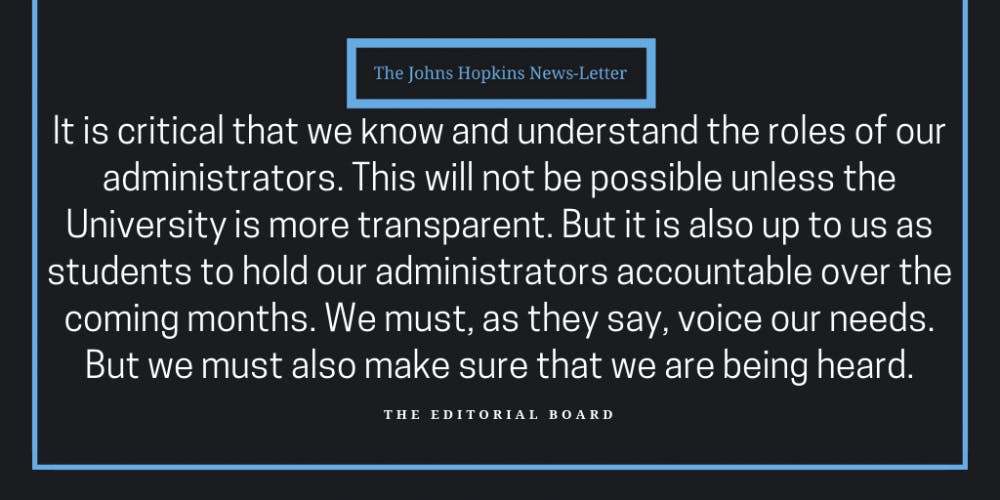The start of a new school year typically brings several changes to campus. This year, however, marks the beginning of some particularly dramatic changes. Most notably, while a student center will not be around for years to come, we are finally in the beginning stages of designing one. And despite widespread pushback from students and communities, the University will begin implementing a private police force.
At the same time, we’ve noticed that changes in administration have become unusually frequent over these past months. Most recently, Provost Sunil Kumar sent out a university-wide email on leadership changes on Aug. 6. Kevin Shollenberger, former vice provost of student affairs, is moving into the newly created position of vice provost for student health and well-being. Replacing him is Alanna Shanahan, former director of athletics and recreation. Jennifer Baker, former senior associate director of athletics, will replace Shanahan.
While we would like to congratulate Shollenberger, Shanahan and Baker on their new positions, the email left us with some pressing questions over the summer. Why, at a time of such sweeping change at our university, are administrators handing off their responsibilities?
We’re at a time when it’s more critical than ever that we are able to hold our administrators accountable. That can be difficult, given the overwhelming number of deans and provosts who run this University. It’s difficult for the average student to understand the role of each administrator.
In an effort to familiarize ourselves with administrators at Hopkins, we found an organizational chart titled “Johns Hopkins University Principal Administrative Officers and Deans.” Hopkins released the chart in 2014; we struggled to find a more recent edition. The chart concisely lays out the role of each dean and vice president, all under the leadership of President Ronald J. Daniels. It’s a way to learn the names and titles of administrators. But given turnover in the past five years, it’s certainly out of date.
Perhaps the University can be doing more to update this information and make it more reader-friendly for the average student. If students do not know who their administrators are, how can they hold them accountable?
We are hopeful that in their roles, Shollenberger, Shanahan and Baker will be able to initiate positive change on our campus. But we are concerned that this is also symptomatic of a larger problem: that the University may not be well-prepared for implementing these transitions smoothly.
High administrative turnover is not exclusively a Hopkins problem. In a 2018 article for The Chronicle of Higher Education, for The Chronicle of Higher Education, California State University-Dominguez Hills professor Terry McGlynn explains that the “administrative merry-go-round” is destructive to the faculty, who struggle to maintain a sense of consistency at work. Because there are few opportunities for promotion in the career of a provost, most who take the job see it as a temporary stepping stone in their overall career prospects. However, when they leave their role, they create a gaping hole at the University that must be quickly filled. We urge our own administrators to see their jobs as meaningful and long-lasting, rather than temporary pathways to positions elsewhere.
As someone new to her role, Shanahan says that she plans to spend the semester listening to student input to learn about the needs and desires of the Hopkins community. We hope that she is sincere in prioritizing student needs. In an interview with our reporters, she encourages students and community members to voice their thoughts on the proposed police force; that is something that they have been doing over the past year. When they contribute their thoughts in the coming months, we urge her to do more than just listen.
We know that Shanahan is qualified to execute positive changes. Kumar’s email notes that she helped spearhead the expansion of the O’Connor Recreation Center. Running this operation puts her in a good position to lead the development of the new student center, a task which she began last spring.
Choosing Shollenberger as the new vice provost for student health and well-being was a more obvious choice, given his training as a counselor. However, it is unclear why the University wanted to create this new position in the first place, or why Shollenberger couldn’t have taken on the responsibilities of this new position from his previous role as the vice provost of student affairs.
Nonetheless, this new position and efforts to centralize mental health resources across the nine campuses suggest that the University cares about the well-being of students. According to a 2018 report by the Task Force on Student Mental Health and Well-being, students at the University reported feeling overwhelmed “often” or “very often” at a higher frequency compared to those at peer institutions. In addition, the Task Force reported that nearly 30 percent of undergraduates and over 15 percent of graduate students have seriously considered suicide.
We are hoping that Shollenberger’s new position will result in positive changes with regards to mental health resources on campus. However, we feel that the University should be more transparent about whether there was an interview process with multiple candidates involved, what Shollenberger’s goals are and how these goals will be implemented in the future.
This year more than ever, it is critical that we know and understand the roles of our administrators. This will not be possible unless the University is more transparent. But it is also up to us as students to hold our administrators accountable over the coming months. We must, as they say, voice our needs. But we must also make sure that we are being heard.

















